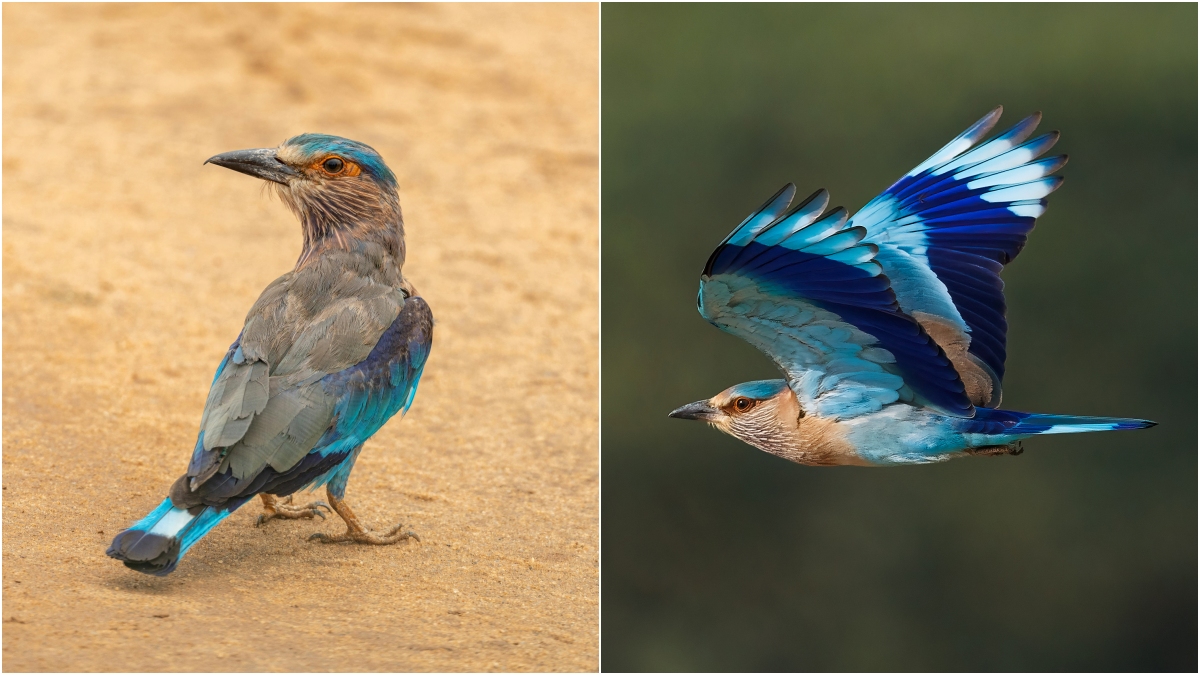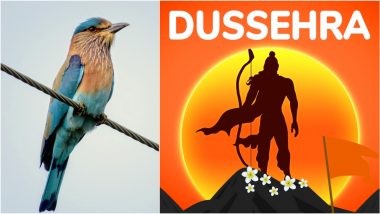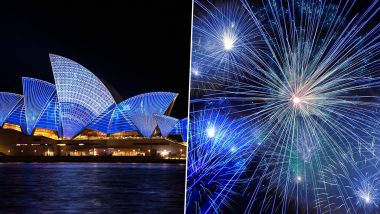Dussehra 2024 will be celebrated on Saturday, October 12. Dussehra, also known as Vijayadashami, is a festival that transcends mere celebration; it symbolises the triumph of good over evil, highlighting the enduring victory of truth and righteousness even in the darkest of times. This festival, celebrated with fervour across India, commemorates Lord Rama's victory over Ravana, the demon king of Lanka. Among the various rituals and traditions associated with Dussehra, one that stands out is the auspicious sighting of the Neelkanth bird, also known as the Indian Roller. Dussehra 2024: What Does Apta Leaves Look Like? View Photos and Know the Significance of Exchanging Sona Patta or Apta Leaf on Vijayadashami.
The Neelkanth: A Bird of Blessings
The Neelkanth bird holds a revered place in Hinduism and is considered a harbinger of good fortune. Spotting this vibrant blue bird on Dussehra is believed to signify luck and prosperity, making it a significant part of the festival’s lore. Various legends weave a rich tapestry connecting the Neelkanth to Dussehra, enhancing its auspicious reputation.

Connections to Lord Shiva
One of the most prominent associations is with Lord Shiva. According to Hindu mythology, during the cosmic event known as Samudra Manthan, or the churning of the ocean, Lord Shiva consumed the poison that emerged to save the universe. This act of self-sacrifice turned his throat blue, leading to the name "Neelkanth," which translates to "blue throat." Thus, the Neelkanth bird symbolises Lord Shiva's protective nature, and seeing it on Dussehra is interpreted as receiving his blessings on this day of victory. Happy Dussehra 2024 Greetings and Ram Ravan Antim Yudh Images: Wishes, WhatsApp Messages, Wallpapers and SMS to Share With Family and Friends.
The Neelkanth is also tied to the narrative of Lord Rama. Legend has it that before embarking on his fateful journey to Lanka to confront Ravana, Rama spotted a Neelkanth bird. This moment is viewed as an omen, signalling that Lord Rama had the blessings of Lord Shiva and was destined for victory. Such connections reinforce the bird's status as an auspicious symbol during Dussehra, aligning its sighting with themes of divine support and triumph over evil.
Symbol of Victory and Luck
Beyond its mythological ties, the Neelkanth bird is celebrated for its stunning plumage and agility. Its vibrant colours and adept flying abilities are seen as emblematic of victory and good fortune. The rarity of spotting a Neelkanth during Dussehra further enhances its significance; as a migratory bird, its presence is not guaranteed during this season. Thus, encountering a Neelkanth becomes a rare and special event, making it even more meaningful when it occurs on this auspicious day.
Making Wishes and Offering Prayers
For those fortunate enough to catch a glimpse of a Neelkanth on Dussehra, it is customary to view this as a moment of good fortune. Many people take this opportunity to make wishes or offer prayers, believing that such gestures, combined with the auspicious sighting, can attract blessings and prosperity in the year ahead.
The Neelkanth bird is far more than just a colourful avian presence; it embodies deep cultural and spiritual significance during Dussehra. Its associations with divine figures like Lord Shiva and Lord Rama, combined with its symbolism of victory and prosperity, make it a cherished emblem of the festival. As families come together to celebrate the triumph of good over evil, the sighting of a Neelkanth adds a layer of hope and blessing to the festivities, reinforcing the bond between nature, culture, and spirituality.
(The above story first appeared on LatestLY on Oct 12, 2024 08:21 AM IST. For more news and updates on politics, world, sports, entertainment and lifestyle, log on to our website latestly.com).













 Quickly
Quickly





















